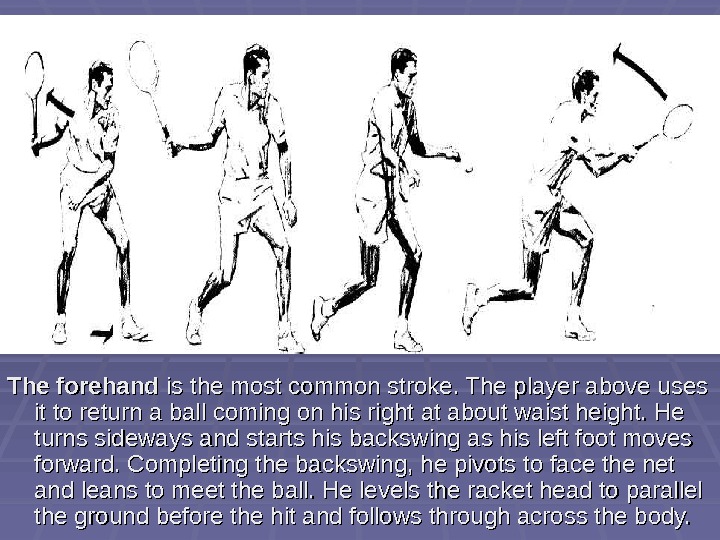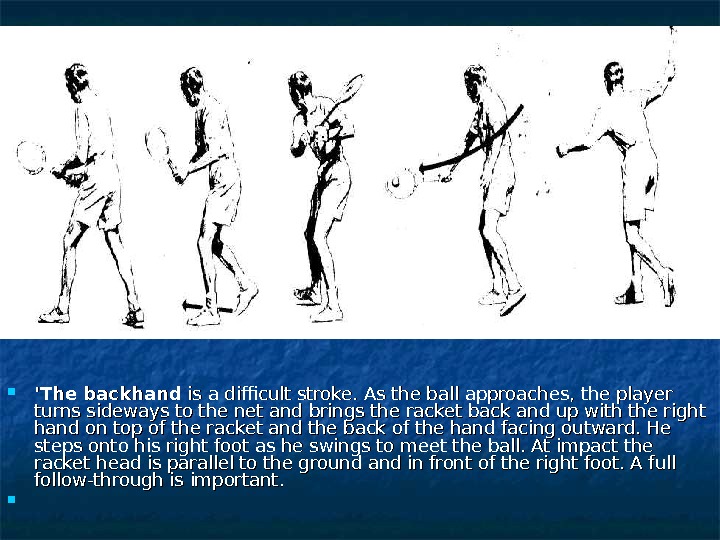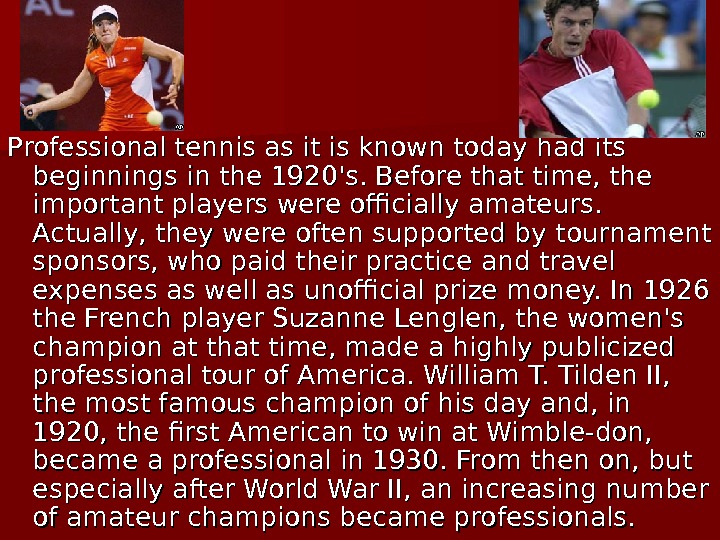Basic strokes in Tennis The serve











- Размер: 574.5 Кб
- Количество слайдов: 10
Описание презентации Basic strokes in Tennis The serve по слайдам
 Basic strokes in Tennis The serve , , which puts the ball into play, varies with the style of the player. In a standard serve the ball is tossed in the air from about waist height. The player bends his knees forward and leans back. In the back position, he lets his wrist break sharply as he rises on his toes. He comes down on the ball with a flat stroke that follows through across the left leg.
Basic strokes in Tennis The serve , , which puts the ball into play, varies with the style of the player. In a standard serve the ball is tossed in the air from about waist height. The player bends his knees forward and leans back. In the back position, he lets his wrist break sharply as he rises on his toes. He comes down on the ball with a flat stroke that follows through across the left leg.
 The forehand is the most common stroke. The player above uses it to return a ball coming on his right at about waist height. He turns sideways and starts his backswing as his left foot moves forward. Completing the backswing, he pivots to face the net and leans to meet the ball. He levels the racket head to parallel the ground before the hit and follows through across the body.
The forehand is the most common stroke. The player above uses it to return a ball coming on his right at about waist height. He turns sideways and starts his backswing as his left foot moves forward. Completing the backswing, he pivots to face the net and leans to meet the ball. He levels the racket head to parallel the ground before the hit and follows through across the body.
 ‘The backhand is a difficult stroke. As the ball approaches, the player turns sideways to the net and brings the racket back and up with the right hand on top of the racket and the back of the hand facing outward. He steps onto his right foot as he swings to meet the ball. At impact the racket head is parallel to the ground and in front of the right foot. A full follow-through is important.
‘The backhand is a difficult stroke. As the ball approaches, the player turns sideways to the net and brings the racket back and up with the right hand on top of the racket and the back of the hand facing outward. He steps onto his right foot as he swings to meet the ball. At impact the racket head is parallel to the ground and in front of the right foot. A full follow-through is important.
 History Lawn tennis is an invented game, unlike most other games, which developed over a long period of time. In 1873, Major Walter Clopton Wingfield, a retired British army officer, invented a new outdoor game based partially on several indoor games, including court tennis, which is also known as real, or royal, tennis. Court tennis probably originated in France in the Middle Ages. It was played on a rectangular court, usually made of stone. Court tennis was a favorite sport of the nobility, and one of the most famous courts, which is still in use, was built by King Henry VIII at Hampton Court Palace, England.
History Lawn tennis is an invented game, unlike most other games, which developed over a long period of time. In 1873, Major Walter Clopton Wingfield, a retired British army officer, invented a new outdoor game based partially on several indoor games, including court tennis, which is also known as real, or royal, tennis. Court tennis probably originated in France in the Middle Ages. It was played on a rectangular court, usually made of stone. Court tennis was a favorite sport of the nobility, and one of the most famous courts, which is still in use, was built by King Henry VIII at Hampton Court Palace, England.
 ► Major Wingfield patented his new game and gave it the Greek name «Sphairistike, » which means «play ing at ball. » The game came to be called lawn tennis, to distinguish it from indoor tennis games. ► As Wingfield’s game became popular, its rules caused confusion. In 1877 the All-England Croquet Club of Wimbledon, England, became alarmed at the fact that the popularity of lawn tennis was causing a decline in popularity of croquet. Therefore, the club decided to hold its own lawn tennis championship tournament under a set of rules of its own devising. This led to the formation of the Lawn Tennis Associa tion, which governs the sport in Great Britain.
► Major Wingfield patented his new game and gave it the Greek name «Sphairistike, » which means «play ing at ball. » The game came to be called lawn tennis, to distinguish it from indoor tennis games. ► As Wingfield’s game became popular, its rules caused confusion. In 1877 the All-England Croquet Club of Wimbledon, England, became alarmed at the fact that the popularity of lawn tennis was causing a decline in popularity of croquet. Therefore, the club decided to hold its own lawn tennis championship tournament under a set of rules of its own devising. This led to the formation of the Lawn Tennis Associa tion, which governs the sport in Great Britain.
 Tennis soon spread to the United States. In 1874 a Sphairistike court was laid out on Staten Island, New York, and lawn tennis was soon firmly established in New York City, Boston, and Philadelphia. The United States National Lawn Tennis Association was orga nized in 1881 as the national governing body. Lawn tennis also spread to the European continent, Australia, and eventually throughout the world. In most countries national governing bodies were established and rules quickly became standardized. They have remained virtually the same throughout the years, despite changes in playing techniques and styles.
Tennis soon spread to the United States. In 1874 a Sphairistike court was laid out on Staten Island, New York, and lawn tennis was soon firmly established in New York City, Boston, and Philadelphia. The United States National Lawn Tennis Association was orga nized in 1881 as the national governing body. Lawn tennis also spread to the European continent, Australia, and eventually throughout the world. In most countries national governing bodies were established and rules quickly became standardized. They have remained virtually the same throughout the years, despite changes in playing techniques and styles.
 Professional tennis as it is known today had its be ginnings in the 1920’s. Before that time, the important players were officially amateurs. Actually, they were often supported by tournament sponsors, who paid their practice and travel expenses as well as unofficial prize money. In 1926 the French player Suzanne Lenglen, the women’s champion at that time, made a highly publicized professional tour of America. William T. Tilden II, the most famous champion of his day and, in 1920, the first American to win at Wimble-don, became a professional in 1930. From then on, but especially after World War II, an increasing number of amateur champions became professionals.
Professional tennis as it is known today had its be ginnings in the 1920’s. Before that time, the important players were officially amateurs. Actually, they were often supported by tournament sponsors, who paid their practice and travel expenses as well as unofficial prize money. In 1926 the French player Suzanne Lenglen, the women’s champion at that time, made a highly publicized professional tour of America. William T. Tilden II, the most famous champion of his day and, in 1920, the first American to win at Wimble-don, became a professional in 1930. From then on, but especially after World War II, an increasing number of amateur champions became professionals.
 The shift toward professionalism in tennis was completed in 1968 when Wimbledon, the first and most prestigious championship match in the world, became an open tournament. It accepted professional players and offered official prize money rather than ‘’expenses’’. Since then, all major tournaments have operated in similar fashion and almost all championship level players have entered the professional circuit. I Leading tennis players since Tilden and Lenglen have included Fred Perry, Don Budge, Rod Laver, Jimmy Connors, Bjorn Borg, and John Mc. Enroe among the men players and Helen Wills, Maureen Connolly, Billie Jean King, Chris Evert, and Martina Navratilova among the women players.
The shift toward professionalism in tennis was completed in 1968 when Wimbledon, the first and most prestigious championship match in the world, became an open tournament. It accepted professional players and offered official prize money rather than ‘’expenses’’. Since then, all major tournaments have operated in similar fashion and almost all championship level players have entered the professional circuit. I Leading tennis players since Tilden and Lenglen have included Fred Perry, Don Budge, Rod Laver, Jimmy Connors, Bjorn Borg, and John Mc. Enroe among the men players and Helen Wills, Maureen Connolly, Billie Jean King, Chris Evert, and Martina Navratilova among the women players.
 Championships and Tournaments The major tournaments for individual players are the national championships of Australia, France, Great Britain (Wimbledon), and the United States. Together, they comprise the «grand slam. » International team tournaments are also held annually. The Davis Cup, donated in 1900 by an American, Dwight Davis, is competed for by men’s teams from many countries. The Wightman Cup. donated in 1923 by former tennis champion Hazel Hotchkiss Wight man, is competed for by American and British women’s teams. The International Lawn Tennis Federation Cup is awarded to the best women’s team among the many competing nations.
Championships and Tournaments The major tournaments for individual players are the national championships of Australia, France, Great Britain (Wimbledon), and the United States. Together, they comprise the «grand slam. » International team tournaments are also held annually. The Davis Cup, donated in 1900 by an American, Dwight Davis, is competed for by men’s teams from many countries. The Wightman Cup. donated in 1923 by former tennis champion Hazel Hotchkiss Wight man, is competed for by American and British women’s teams. The International Lawn Tennis Federation Cup is awarded to the best women’s team among the many competing nations.


